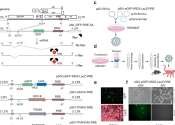Why is a cure for HIV so elusive?
Schulich School of Medicine & Dentistry researchers are on the cutting-edge of the study of HIV, working toward treatments and a better understanding of how the virus works.
Nov 29, 2024
0
0
Schulich School of Medicine & Dentistry researchers are on the cutting-edge of the study of HIV, working toward treatments and a better understanding of how the virus works.
Nov 29, 2024
0
0

A University of Minnesota Medical School research team has found that giving iron supplements to children living with human immunodeficiency virus (HIV) in sub-Saharan Africa could be an important first step in optimizing ...
Oct 31, 2024
0
0

All mammals can develop cancer, the rapid growth of harmful cells that can overtake normal cells and compromise their ability to function. Scientists have long observed that a species of nearly-hairless subterranean rodents ...
Oct 30, 2024
0
17

Ancient viral remnants in the human genome are activated during pregnancy and after significant bleeding in order to increase blood cell production, an important step toward defining the purpose of "junk DNA" in humans, according ...
Oct 25, 2024
0
200

A multiomic analysis led by the IrsiCaixa AIDS Research Institute has uncovered genetic and immune mechanisms in some HIV-positive individuals, known as viremic non-progressors (VNPs), to avoid disease progression without ...

In the late 1980s, Linda Rose Frank began working with HIV-positive individuals at the University of Pittsburgh. At the time, those affected were mainly young men with a terrifying prognosis.
Sep 2, 2024
0
0

MacArthur Flournoy has lived with HIV since 1988, though a nurse at the time told him that he would likely die within two years.
Jul 29, 2024
0
0

Researchers in George Mason University's Center for Infectious Disease Research (CIDR) and Tulane National Primate Research Center have conducted a breakthrough proof-of-concept study, published in the journal Gene Therapy, ...
Jul 24, 2024
0
19

A study led by researchers at the American Cancer Society (ACS) finds four in 10 cancer cases and about one-half of all cancer deaths in adults 30 years old and older in the United States (or 713,340 cancer cases and 262,120 ...
Jul 11, 2024
0
192

A multinational team led by Weill Cornell Medicine investigators developed a test that will help measure the persistence of HIV in people affected by viral strains found predominantly in Africa—a vital tool in the search ...
Jul 2, 2024
0
55

Human immunodeficiency virus (HIV) is a lentivirus (a member of the retrovirus family) that causes acquired immunodeficiency syndrome (AIDS), a condition in humans in which progressive failure of the immune system allows life-threatening opportunistic infections and cancers to thrive. Infection with HIV occurs by the transfer of blood, semen, vaginal fluid, pre-ejaculate, or breast milk. Within these bodily fluids, HIV is present as both free virus particles and virus within infected immune cells. The four major routes of transmission are unsafe sex, contaminated needles, breast milk, and transmission from an infected mother to her baby at birth (perinatal transmission). Screening of blood products for HIV has largely eliminated transmission through blood transfusions or infected blood products in the developed world.
HIV infection in humans is considered pandemic by the World Health Organization (WHO). Nevertheless, complacency about HIV may play a key role in HIV risk. From its discovery in 1981 to 2006, AIDS killed more than 25 million people. HIV infects about 0.6% of the world's population. In 2009, AIDS claimed an estimated 1.8 million lives, down from a global peak of 2.1 million in 2004. Approximately 260,000 children died of AIDS in 2009. A disproportionate number of AIDS deaths occur in Sub-Saharan Africa, retarding economic growth and exacerbating the burden of poverty. An estimated 22.5 million people (68% of the global total) live with HIV in sub-Saharan Africa, which is also home to 90% of the world's 16.6 million children orphaned by HIV. Treatment with antiretroviral drugs reduces both the mortality and the morbidity of HIV infection. Although antiretroviral medication is still not universally available, expansion of antiretroviral therapy programs since 2004 has helped to turn the tide of AIDS deaths and new infections in many parts of the world. Intensified awareness and preventive measures, as well as the natural course of the epidemic, have also played a role. Nevertheless, an estimated 2.6 million people were newly infected in 2009.
HIV infects vital cells in the human immune system such as helper T cells (specifically CD4+ T cells), macrophages, and dendritic cells. HIV infection leads to low levels of CD4+ T cells through three main mechanisms: First, direct viral killing of infected cells; second, increased rates of apoptosis in infected cells; and third, killing of infected CD4+ T cells by CD8 cytotoxic lymphocytes that recognize infected cells. When CD4+ T cell numbers decline below a critical level, cell-mediated immunity is lost, and the body becomes progressively more susceptible to opportunistic infections.
Most untreated people infected with HIV-1 eventually develop AIDS. These individuals mostly die from opportunistic infections or malignancies associated with the progressive failure of the immune system. HIV progresses to AIDS at a variable rate affected by viral, host, and environmental factors; most will progress to AIDS within 10 years of HIV infection: some will have progressed much sooner, and some will take much longer. Treatment with anti-retrovirals increases the life expectancy of people infected with HIV. Even after HIV has progressed to diagnosable AIDS, the average survival time with antiretroviral therapy was estimated to be more than 5 years as of 2005[update]. Without antiretroviral therapy, someone who has AIDS typically dies within a year.
This text uses material from Wikipedia licensed under CC BY-SA